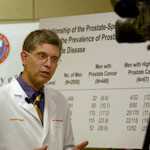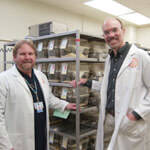What is the prostate? The prostate is a gland that is a part of the reproductive organs and lies below the urinary bladder in men. It serves to produce fluids that are a component of the man’s ejaculate.
What is prostate cancer? Prostate cancer is a cancer that develops from the cells lining the duct structure of the prostate. Most cancers are called adenocarcinomas.
Who is at risk of prostate cancer? All men are at risk. About 17 percent of U.S. men will be diagnosed with prostate cancer during their lifetime, making about one man in six at risk. More than 200,000 men annually in the United States are diagnosed with prostate cancer and about 30,000 men each year die from this disease. Risk factors for developing prostate cancer include:
- Age – prostate cancer is unusual before age 50 but increases in frequency with age.
- Ethnicity/race – Black men have a higher risk for prostate cancer.
- Family history – men with one or more close male relatives with prostate cancer have a higher risk of the disease. In general, the more relatives affected, the greater a man’s risk.
What are the symptoms of prostate cancer? In general, prostate cancer is silent. By the time symptoms develop, such as bone pain, urinary symptoms, blood in urine or weight loss, the prostate cancer has spread and cure is unlikely. While urinary symptoms (arising at night to urinate, slower stream) are common in aging men, these symptoms generally are not related to prostate cancer. Because prostate cancer develops without symptoms, early detection is necessary for cure of the disease.
How is prostate cancer diagnosed? Traditionally, two tests have been used to detect prostate cancer – digital rectal examination (DRE) and prostate-specific antigen (PSA). DRE involves the physician using the gloved finger to examine the prostate through the rectum. The physician is examining for bumps or irregularities in the prostate that can indicate the presence of cancer. The PSA test measures a protein that is made generally only by the prostate and that is increased in men with prostate cancer.
What is a prostate biopsy? If either the DRE or PSA is suspicious for prostate cancer, the physician may recommend a prostate biopsy. The biopsy is performed on an outpatient basis and generally involves use of an ultrasound unit to guide a biopsy needle. Several needle biopsies are obtained, removing tissue for analysis. A pathologist examines the tissue removed to determine if prostate cancer is present.
What is an abnormal PSA reading? Over the past two decades, many physicians have used a PSA level of 4.0 ng/ml (nanograms per milliliter) to separate men who may have prostate cancer from men with a low risk of prostate cancer. Men with a value over 4.0 ng/ml have often been offered a prostate biopsy to determine if prostate cancer is present. For men with a PSA between 4.0 and 10.0 ng/ml, it is frequently cited that the risk of cancer if a biopsy is performed is about 25 percent. (For values over 10.0 ng/ml, the risk increases further.) However, with some exceptions, many men with PSA levels less than 4.0 ng/ml have not been offered a prostate biopsy. While there have been some small groups of men with these ‘normal’ values of PSA who have had a biopsy, very few series have examined this group.
How does this report change what we know about PSA? The Prostate Cancer Prevention Trial, a study funded by the National Cancer Institute and coordinated by the Southwest Oncology Group, reported its conclusions in June 2003. The study enrolled 18,882 men, half receiving the drug finasteride (Proscar) and half receiving an inactive agent (a placebo). Over seven years, men had DRE and PSA testing. If either were abnormal, a prostate biopsy was recommended. At the end of seven years, to ensure that prostate cancer had not developed, all men, even those with a normal DRE and PSA, were recommended to have a prostate biopsy.
In the 2,950 men who had received placebo and who had never had an elevated PSA or abnormal DRE (and who met several other rigorous criteria for this analysis), prostate cancer was detected in 15 percent. The risk of prostate cancer in men with PSA in the ranges of < 0.5, 0.6 to 1.0, 1.1 to 2.0, 2.1 to 3.0, and 3.1 to 4.0 ng/ml was 6.6, 10.1, 17.0, 23.9 and 26.9 percent, respectively. While high-grade (aggressive) prostate cancer increased with higher levels of PSA, there was no level of PSA below which such aggressive cancer did not occur.
How can this information be used? First, it is important to recognize that PSA continues to be an important blood test for the detection of prostate cancer. The risk of both cancer itself and of aggressive disease increases with higher levels of PSA.
For a man with a normal PSA, it must be understood that prostate cancer may be present. For some, the prostate cancer will be of no consequence and could be followed until a PSA level increased. For some men, however, cure of aggressive prostate cancer may be best achieved by detecting the cancer while the PSA level is less than 4.0 ng/ml.
Individuals with a PSA less than 4.0 ng/ml who may consider undergoing a prostate biopsy could include (1) a man with a strong history of prostate cancer, including one or more relatives who developed the disease at a young age, (2) a black man. Both of these groups have a significantly higher risk of prostate cancer and are at risk of developing the disease at a younger age.
Because prostate cancer, even aggressive prostate cancer, can develop in men with no risk factors at all for the disease, a man with a normal level of PSA may want to examine the prostate cancer detection risk for his own level of PSA, using the results from this study. Different men will have different levels of risk that will lead them to select a prostate biopsy.
What is the future of prostate cancer detection?
Work is ongoing to examine improved methods of prostate cancer detection. The PSA test measures only one of more than 100,000 proteins in the blood, and there is evidence to suggest that other substances may help to find those men with prostate cancer. The University of Texas Health Science Center at San Antonio’s SABOR program, the San Antonio Center For Biomarkers Of Risk Of Prostate Cancer, is a member of the National Cancer Institute’s Early Detection Research Network and is working to identify a group of tests and risk factors.
A panel of genetic markers, dietary factors and other measures are being examined to determine if they can improve prostate cancer detection. The ultimate goal of this program is to identify not just the man with prostate cancer (because in some men, the cancer will never cause him problems in his lifetime), but to identify those men whose prostate cancers are destined to cause problems and to detect them sufficiently early to allow treatment for cure.
Who can participate in SABOR? Currently, more than 3,000 men from San Antonio and South Texas are enrolled in the study. Of these men, more than half are either Hispanic or black. This is a major feature of the SABOR study, as evidence suggests that risk factors and blood tests may work differently in men of different ethnic and racial backgrounds. While men over age 40 generally enter in the SABOR study, some men at younger ages have enrolled due to strong family history of prostate cancer or other factors that increase their risk.
What is involved in SABOR visits? Men who are interested in SABOR are given information to read and have an opportunity to ask questions about the study. Because this is a research study, an informed consent is required and the study is overseen by The University of Texas Health Science Center at San Antonio’s Institutional Review Board. At the first visit, in addition to a prostate examination and blood tests, questions are asked about family history of cancer and personal medical history, as well as any urinary symptoms. Men are asked to take home and complete questionnaires regarding their diet and use of dietary supplements. The next time SABOR participants cut their toenails, they are requested to send in the clippings, as these can help to examine dietary selenium, a possible prostate cancer preventive factor. On an annual basis, men in SABOR have a prostate examination and a blood test and are asked to update their medical and family history.
Complete information regarding SABOR can be obtained by calling (210) 567-0214 or (800) 335-4594. SABOR clinics are held in a number of locations around San Antonio, in Laredo and in McAllen.
Are there any other options other than early detection of prostate cancer? The results of the Prostate Cancer Prevention Trial demonstrated that a man who took finasteride, a drug that is used for enlarge of the prostate – both to treat urinary symptoms as well as to reduce the risk of progression of urinary symptoms – lowered his risk of prostate cancer by 25 percent. The side effects of finasteride include a risk of sexual problems and a possibility of development of a more aggressive prostate cancer. The additional benefit of this medication is the improvement in urinary function and reduction in long-term risk of urinary problems. A smaller dose of finasteride (1mg) is used to treat male pattern baldness.





